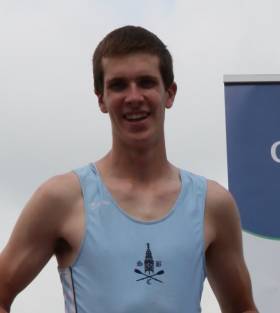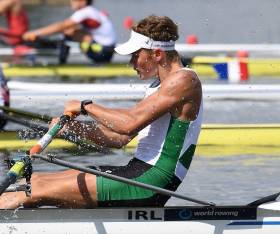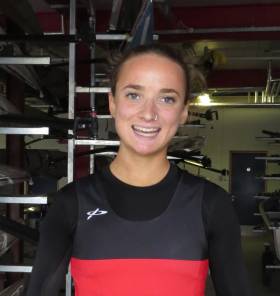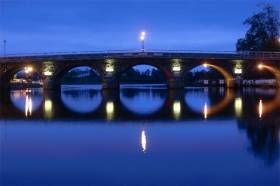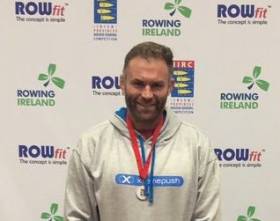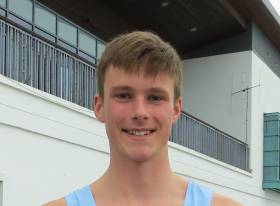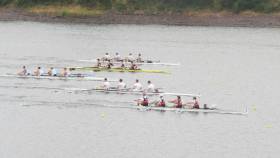Displaying items by tag: Shandon
Shandon Top Rankings at Skibbereen Head of the River UPDATE
Shandon's senior men's eight were the fastest rowing crew at the Skibbereen Head of the River at the Marina in Cork on Saturday. They covered the course in nine minutes 4.97 seconds.
Andrew Sheehan of Lee, a junior 18 competitor, was the fastest single sculler in 11 minutes 29.22 seconds. Junior women’s sculler Hannah Gahan of Cork Boat Club topped the rankings.
Cork Boat Club's women's eight (bow number 268) were the fastest women's crew.
The head was held in very good conditions, though there was some difficulty due to bigger craft earlier in the day.
Sutton and Legresley Win Time Trial for Cork Sculling Ladder
#Rowing: Hugh Sutton of UCC Rowing Club was the overall winner of the 48th Cork Sculling Ladder time trial, which was run on calm water and on an outgoing tide at the Marina on the River Lee on Sunday. Sutton covered the 1800 metres in seven minutes and 3.4 seconds. Jessica Legresley of Shandon Boat Club won the women’s trial in 7:57.5.
Two previous winners of the the ladder, Jack Dorney and Andy Harrington, set a time of 6:42.1 as they won the first coxless pairs time trial. Amy Mason and Grace Collins won the the women’s pairs time trial in 7:36.1.
The event, which was sponsored by Argos Fire, had a big entry. The oldest competitor on the day was 83-year-old Seamus Quane of Shandon Boat Club.
The sculling and coxless pairs ladders continue with two-boat racing until March 2020.
Davis Of Lee Valley the Irish Junior Champion at Fourteen
#Rowing: Holly Davis gave the crowds a sensational result at the Irish Championships. The Lee Valley girl came through a good battle with Eabha Benson of St Michael's, to pull away and win. The remarkable thing is that Davis is just 14. She does not turn 15 until January 10th next year, leaving her with four years at Junior level.
The men's junior coxed four also electrified the crowd: Colaiste Iognaid and Enniskillen duked it out down the course. The Galway crew got away to win as their emotional supporters roared them on.
Youth was the theme of this regatta: Kevin O'Donovan, who is a junior, won the club single, while Anna Tyther, also under 18 teamed up with Zoe Hyde to win the intermediate double for Killorglin.
The three other titles on offer in this first Saturday session went three different ways: Commercial's strong senior men's programme was on show as they won the men's quadruple; Cork had a fine win in the intermediate men's eight; Trinity's A crew won the women's novice eight.
Cremen and Dorney Top Rankings on Cork Sculling Ladder
#Rowing: Jack Dorney of Shandon and Margaret Cremen of Lee were the overall winners of the Cork Sculling Ladder. The presentations will take place this Thursday (January 31st) at Cork Boat Club. The Ladder is sponsored by Argos Fire.
Cork Sculling Ladder - Overall Winner : (1) Jack Dorney - Shandon Boat Club.
Women’s Overall Winner: (13) Margaret Cremen - Lee Rowing Club (retained)
Section Winners
Men
Jack Dorney - Shandon Boat Club, Open, Intermediate, Club 1, Club 2, Junior 18 and Junior 16
Jack Kiely - Lee Rowing Club, Novice
Peter Leonard - Cork Boat Club, Junior 15 and Junior 14
David Ross – Chu - Shandon Boat Club, Junior 13
Cian Dunlop - Lee Rowing Club, Junior 12
Donal Smith - Shandon Boat Club, Masters A & B
Henrik Merz - Shandon Boat Club, Masters C
John O’Neill - Shandon Boat Club, Masters D
Tony Corcoran - Lee Valley Rowing Club, Masters E, F, G & H
Women
Margaret Cremen - Lee Rowing Club, Open, Intermediate and Junior 18
Aoife Lynch - Lee Rowing Club, Club 1, Junior 16 and Junior 15
Claragh O’Sullivan - Cork Boat Club, Club 2
Maeve Coakley - Lee Rowing Club, Novice
Jennifer Forde - Shandon Boat Club, Junior 14
Isobel McElwain - Lee Rowing Club, Junior 13
Emer Hannon - Lee Rowing Club, Junior 12
Jessica Legresly - Shandon Boat Club, Masters A & B
Vivian Kelleher - Lee Rowing Club, Masters C
Liz Buckley - Lee Rowing Club, Masters D
Good Day for Shandon and Coláiste Iognáid
#Rowing: The weather held up well for both the Muckross Head of the River and the Head of the Shannon at Carrick on Shannon today.
Shandon’s men’s intermediate eight topped the Muckross provisional rankings at the National Rowing Centre, while their men’s senior quadruple and men’s club eight placed fifth and sixth. UCC’s women’s club eight were the fastest women’s crew.
The Coláiste Iognáid men’s junior 18 eight took the honours at Carrick on Shannon. They competed in the second head, at 2 o’clock, which had the superior weather conditions. Commercial’s men’s senior eight took second.
Byrne Sets Junior Record at Provinces Indoor Rowing
#Rowing: Ocean rower Damian Browne and junior rowers Alex Byrne and Caoimhe O’Sullivan were amongst the record breakers at the Provinces Indoor Rowing Championships in the University of Limerick on Saturday.
Shandon rower Byrne hit six minutes and five seconds for the 2,000 metres category, while O’Sullivan of Muckross covered 1,000 metres in three minutes 44.6 seconds.
Browne, a former professional rugby player who completed his row across the Atlantic earlier this year, took and beat the old record for 500 metres. He set a new time of one minute 16 seconds.
Records set at the Provinces Indoor Rowing Championships, University of Limerick, Saturday:
Men – Open 500m: Damian Browne 1 min 16 sec. Lightweight, Open 500m: Aidan Greene, Kincasslagh RC 1:28.7. Jun 18, 2,000m: Alex Byrne, Shandon RC 1:28.7.
Women – Lightweight Open 500m: Niamh Doogan, Kincasslagh RC 1:45.1. Jun 16 1,000m: Caoimhe O’Sullivan, Muckross.
Shandon Excel at Cork Head of the River
#Rowing: Shandon amassed a big set of wins at the Cork Head of the River at the Marina on Saturday. Their men’s senior quadruple, competing in the fourth head, set the fastest time of 12 minutes 3.4 seconds, while their men’s senior eight were just .6 of a second slower. They competed in head one and were the second-fastest crew overall. Jack Dorney was the fastest single sculler.
Cork Boat Club's women reeled off a set of wins. The fastest women’s crew was their club two eight, while Grace Collins of the same club was the fastest women’s single sculler.
Cork Head of the River, The Marina, Saturday (Selected Results)
Overall: 1 Shandon men’s senior quadruple 12 minutes 3.4 seconds (Head Four), 2 Shandon men’s senior eight 12 mins 4 secs (Head One), 3 Cork men’s inter eight 12:17.3 (H1).
Men
Eight – Senior: Shandon 12:04.0. Inter: Cork 12.17.3. Club Two: Shandon 13.13.
Four – Sen: Shandon 12:37. Inter, coxed: Shandon 13:55.3. Club Two, coxed: Waterford 15:41.6. Jun 18A, coxed: Shandon 14:13.3.
Pair – Sen: Cork A 13:44.1. Jun 18A: Fermoy 14:28.9. Jun 16, coxed: Presentation (Rolling Head) 14:24.6. Masters, coxed: Shandon (b) 15:17.4.
Sculling – Quadruple – Sen: Shandon 12:03.4. Inter: Shandon 12:36.2. Jun 18A: Lee B 12:53.1. Masters, coxed: Shandon A (a) Rolling Head 15:24.8
Double – Club Two: Shandon 15:27.5. Jun 18A: Cork 13:41.3.
Single – Sen: 1 Shandon (J Dorney, sen, H2) 15:18.8. Inter: Cork (C O’Sullivan) 15:44.7. Club Two: Lee (P Hearty) 18:11.1. Jun 18A: Lee (A Sheehan, H2) 15:30.2. Jun 16: Kenmare (T Kelly) 15:48.7. Masters: Shandon (H Merz, d; Rolling Head) 15:25.7.
Women
Eight – Club Two: Cork 14:28.5. Pair - Sen: Cork 16:47.2. Jun 18: Cork A 16:08.
Four – Club Two, coxed: Cork A 15:04.9. Masters, coxed: Cork (d) 16:38.4.
Sculling – Quadruple – Inter: Cork 15:27.3. Jun 18A: Shandon A 15:23.1. Jun 16, coxed: Lee 16:19.2. Masters, coxed: Graiguenamanagh (b) 17:15.2.
Double – Inter: Cork A 15:11. Jun 18A: Lee A 15:37.3.
Single – Inter: Cork (G Collins) 16:13.4. Club Two: Shandon (J Legresley) 16:01.5. Novice: Lee (O Commins) 17:35.9. Jun 18A: Kenmare (E Crowley) 15:38.7. Jun 16: Shandon (J Forde) 15:55.9. Masters: Shandon (J Legresley; b) 17:49.8 (Rolling Hd)
Cork Clubs Come to Fore at Irish Rowing Championships
#Rowing: UCC brought their title tally to three as they added the club coxed four to their club eights and intermediate single sculls pots at the Irish Rowing Championships today. The four was tested by four other crews coming to the line but broke free and won. The morning session on the Sunday was held in intermittent light rain.
Margaret Cremen won the women’s lightweight single sculls. The Lee woman looked dominant through much of the race, but as she approached the line she was hunted down by Orla Hayes of Skibbereen, who closed to just a few seconds on the line. Hayes’s clubmate, Aodhan Burns, left no doubts as to his intentions in the men’s lightweight single. He left the rest behind and won well.
The men’s intermediate pair gave Shandon a chance to demonstrate the depth of their talent pool. Stephen O’Sullivan and Colm Hennessy teamed up to win. The Castleconnell junior double of James Desmond and Rory O’Neill came under pressure from Lee in their win.
One of the closest races in the Championships so far came in the women’s intermediate four. Leaders Trinity were pipped on the line by Cork, whose winning margin was under a third of a second (.312).
Killorglin’s Anna Tyther and Rhiannon O’Donoghue gave Fermoy a test in the women’s junior pair. Gill McGirr and Eliza O’Reilly are an excellent crew, however, and held off their Kerry rivals.
Irish Rowing Championships, Day Three (Selected Results)
Men
Four – Club, coxed: UCC A 6:38.03.
Pair – Inter: Shandon A 6:56.07.
Sculling, Double – Junior: Castleconnell (R O’Neill, J Desmond) 6:49.97.
Lightweight Single: Skibbereen (A Burns) 7:20.56.
Women
Four – Inter, coxed: Cork 7:22.36.
Pair – Junior: Fermoy (E O’Reilly, G McGirr) 7:48.69.
Sculling, Lightweight Single: 1 Lee (M Cremen) 8:06.97.
Championship Records Tumble at National Rowing Centre
#Rowing: Records fell in race after race in the final Saturday session of the Irish Championships. The Skibbereen senior quadruple of Fintan McCarthy, Aodhan Burns, Kealan Mannix and Jake McCarthy smashed the Championship best of 5:59.10 as they won in 5:50.696.
The Shandon junior quadruple of Eoin Gaffney, Luke Hayes-Nally, Jack Dorney and Alex Byrne – all set to compete at the World Junior Championships – set a new time of 5:58.26. This beat the old Championship record of 6:07.97.
In both cases the crews were bettering times set by their own club.
Lisa Dilleen’s win in the women’s senior single scull was emphatic. The Cork Boat Club sculler set a Championship course record of 7:34.282, bettering Monika Dukarska’s time of 7:35.07.
Ronan Byrne of UCC took the intermediate single, under some pressure from Niall Beggan of Commercial. Byrne’s time of 6:55.898 bettered Kealan Mannix’s time of 7:03.51, set last year.
Enniskillen took the women’s junior eights, in 6:30.753, bettering their own time from last year of 6:36.24.
In the women’s senior pair, Aine McCarthy and Niamh Casey shattered the old Championship record of 7:23.78, setting a new time of 7:17.176.
Joan Poh of Neptune also won the club single sculls in a new record. The old figure was 8:09.22. Poh won in 8:06.13.
UCD continued their fine run in eights by adding the men’s novice title to the intermediate one.
Irish Championships, Day Two (Selected Results)
Men
Eight – Inter: UCD 5:43.70. Novice: UCD 6:03.599.
Four – Junior, coxed: Enniskillen 6:22.66.
Sculling, Quadruple – Senior: Skibbereen 5:50.696. Jun: 1 Shandon 5:58.26
Single – Inter: UCC (R Byrne) 6:55.898. Club: Carlow (F O’Driscoll) 7:25.3.
Women
Eight – Novice: Queen’s 7:04.49. Jun: Enniskillen 6:30.75.
Pair – Senior: Skibbereen 7:17.18.
Sculling, Double – Inter: Skibbereen 7:09.09. Single – Senior: Cork BC (L Dilleen) 7:34.28. Club: Neptune (J Poh) 8:06.1. Jun: Coleraine GS (M Curry) 7:53.46.
#Rowing: Two strong senior composite crews took home the Division One quadruple titles as the action concluded late into the evening on the first day of Cork Regatta at the National Rowing Centre. The women’s final saw Margaret Cremen join Skibbereen’s Lydia Heaphy, Denise Walsh and Aoife Casey to good effect, and the men’s winners were the prospective Ireland Under-23 lightweight quad. Workmen’s and Shandon junior 18 crews were good runners up in the women’s and men’s races.
Cork Boat Club won the Division One men’s coxed four title, while Trinity took the women’s.
Cork Regatta, National Rowing Centre (Selected Results)
Men
Eight – Div Two: Neptune (club two) 6:22.95; 4 Trinity (nov) 6:34.32; 5 Col Iognaid (jun 16) 6:35.63; 6 Shandon (jun 18B) 6:43.79.
Four – Div One, coxed: Cork (inter) 6:34.299; 3 Enniskillen A (jun 18A) 6:39.299. C Final: 2 Neptune (club one) 6:48.37.
Pair – Div One: 1 UCD (S Mulvaney, D O’Malley; sen) 6:53.31, 2 Skibbereen (M O’Donovan, S O’Driscoll; sen) 6:59.98, 3 Enniskillen (jun 18A) 7:06.75; 6 Cork A (inter) 7:23.68. B Final: 6 Neptune A (club one) 7:24.50.
Sculling, Quadruple – Div One: 1 Tara, UCD, Commercial, UCC (sen) 6:00.93, 2 Shandon (jun 18) 6:10.96
Double – Div Two: CRCC (jun 18B) 7:06.99; 5 Cork A (jun 16) 7:15.37. B Final: Cappoquin (club two) 7:20.43
Single Sculls: 1 Skibbereen (P O’Donovan; sen) 6:59.73. B Final: UCC (H Sutton; lwt) 7:20.63. C Final: 1 Shandon (E Gaffney; jun 18A) 7:28.92; 2 Queen’s (N Hull; inter) 7:29.86
Women
Eight- Div Two: Trinity A (club two) 6:52.696; 6 Commercial (jun 16) 7:15.45. B Final: 1 Queen’s (nov) 7:19.09.
Four, coxed – Div One: 1 Trinity (inter) 7:25.63, 2 Commercial (sen) 7:30.06; 5 Shandon (club one) 7:46.78.
Pair – Div One: 1 Skibbereen (A McCarthy, N Casey; sen) 7:49.73; 4 Col Iognaid (Jun 18A) 8:07.86; Shandon (club one) 8:08.78. C Final: 4 Shandon (inter) 8:36.00.
Sculling, Quadruple – Div One: 1 Skibbereen/Lee 6:50.49; 2 Workmen’s (jun 18A) 7:05.596. Div Two: 1 Cork A (club two) 7:50.05; 3 Carlow (jun 16) 8:03.97. B Final: Carlow (jun 18B) 8:13.43; 4 Queen’s (nov) 8:25.47.
Double – Div Two: 1 Killorglin (jun 18B) 7:41.63, 2 New Ross (club two) 7:56.41, 3 Carlow (jun 16) 8:00.41



























